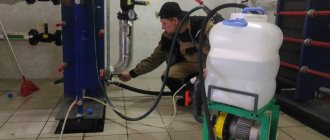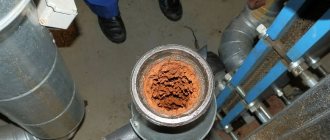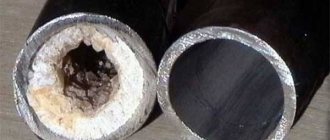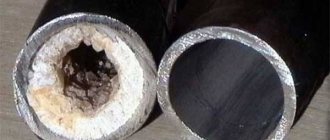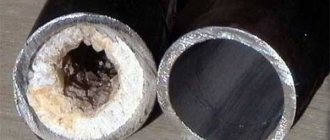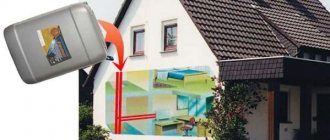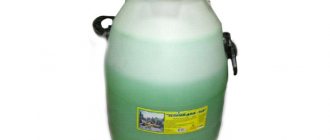Every heating system contains small particles that constantly circulate along with the liquid through the pipes. Most often, such substances are rust, scale or similar elements. When a lot of these components accumulate, problems begin with heating. Debris gets stuck in one place and begins to form deposits, which interfere with normal water circulation, and, consequently, heat exchange becomes worse. Of course, there is a solution to this problem - flushing the heating system.
The editors of the YaNashla website have prepared for you a rating of the best heating system cleaning products for 2022.
Is flushing the system necessary?
It is important to understand that not all apartments and private houses need washing. Since modern manufacturers are creating more innovative devices that do not accumulate sediment. And when heat exchange deteriorates, this does not always indicate pollution. Airing is common; this occurs after filling the system with new fluid. To eliminate this, first remove all the air, then add antifreeze or water. At first (about 2-3 weeks), the coolant will release sediment - this is a normal process, the main thing is to constantly clean the filters where it will fall out. After some time, when the impurities are exhausted, the precipitation of particles will stop.
When a person uses such a system (closed type), it will work for many years without any cleaning. The opposite situation is when heating needs constant replenishment from the outside. Then a person cannot avoid the formation of sediment. After 3-4 years, a large amount of debris will accumulate in the pipes, and sludge will form in the batteries. In this case, flushing is required.
A similar effect can occur due to the penetration of air into a closed system. The bubbles will begin to cause corrosion of the metal elements, which will cause the formation of iron oxide, which will accumulate in the filter all the time. The problem here will not be bad water, but plastic pipes that were manufactured without a protective oxygen barrier.
To ensure that the pipes begin to heat up again and do not leave the owner in the cold, the system should be flushed. But besides this, the cleaning process must be carried out:
- When heating appliances stop giving off heat. This can happen with one element or with several. The first sign is uneven heating of the sections when the bottom is completely cold. It should be understood that standard situations were considered and eliminated, but this did not affect heat transfer.
- When the heating system is constantly filled with fresh water or another substance. This often occurs when a person uses an electrode boiler, since in order for it to function normally, it is necessary to add water with a specific salt value. So the owner constantly monitors the chemical reaction and controls the level of salts or adds new coolant to automate the process.
- When a large amount of oxygen penetrates into the water. Signs of this problem are daily clogging of the sump tank and poor heat transfer, while the boiler operates at its maximum capacity.
If such problems occur, then the only solution is to flush the heating system. In this case, you can forget about frequency, since everything needs to be cleared so that the situation does not get worse. When the user is connected to central heating, then everything is much simpler, since the radiator network is flushed annually, after this stage pressure testing is carried out. It is carried out according to special standards.
Algorithm for cleaning the radiator
- We remove all unnecessary things and furniture from the heating radiator that may interfere with or delay flushing. If there are curtains hanging near it, you need to remove them. In addition, if the room uses laminate or parquet as flooring, then it is necessary to spread some piece of fabric or film under the radiator - this is done so as not to harm the floor.
Before starting work, you must turn off all taps
It is necessary to shut off the water supply to the radiator. If there is no shut-off valve that allows this to be done, then you will have to go the other way - drain the water from the heating system. Take a regular bucket, remove the radiator by unscrewing it from the rest of the equipment, and drain the water present in it into the prepared bucket. The cleaning process is just beginning and then you need to take the heating radiator to the bathroom and then place it in the bathtub. There is a risk of causing mechanical damage to it in the form of scratches, and in order to prevent such a development of events, place something like a wooden pallet under the radiator. If you live in a private house and not in an apartment, then to flush the radiator you will need to take it out into the yard.
The end fittings are unscrewed using a wrench
We unscrew the end fittings using a wrench. This must be done in the yard or in the bathroom, otherwise you can fill the floor with a cloudy and littered liquid that has a very unpleasant odor, and you will create another problem for yourself - you will need to clean the floor.
Next, you need to rinse the heating radiator from the inside; to do this, we supply water under pressure from a hose or shower into the holes at the end.
- Sometimes owners are forced to deal with crystalline blockages, and in this case slightly different means are needed. You can't do without a concentrated vinegar solution. We install the end fittings at the bottom and pour vinegar inside. Before using vinegar, it is recommended to dilute it 70% with water. This flushing will help remove stubborn blockages from the heating radiator. The solution should sit for about two hours, after which it should be poured out and the radiator should be cleaned with water pressure to achieve complete cleansing.
- You can also wash the external surfaces of the radiator to give it a nice and clean look.
One of the reasons for clogging may be scale formation
The radiator should be placed on wall mounts and the threaded connections on it should be lightly cleaned with a cloth, which must be dry. If you have a cast iron radiator, then screw tow onto all the fittings in the direction of the threads and apply paint to the seal. It is allowed to use any paint related to “Nitro” and “Enamel”. Using a two-piece gas wrench, tighten the fittings tightly. If the apartment has more modern radiators, then it is recommended to use film for waterproofing purposes. Do not use tow or paint.
So, as we see, there is nothing overly complicated about cleaning the radiator. This will not require any special skills or knowledge, just as you will not need any rare means and tools that are difficult to obtain. If done responsibly, this procedure will not take too much time and effort, and therefore every owner can clean the radiator on their own. However, there are situations where even after all the measures have been taken and the radiators are installed in their place, the heating system still functions poorly. In this case, you need to buy a new radiator and replace the old one, or use the services of specialized companies that carry out cleaning with a technical booster.
Rating of the best concentrates for the heating system
TermoTactic CleanMaster
A good concentrate, which is intended for use in heating, ventilation and air conditioning systems. Thoroughly remove scale, traces of corrosion and carry out disinfection. The composition is completely safe for metal products and will not damage them during the cleaning process.
Sold at a price of 1,600 rubles per 10 kg.
TermoTactic CleanMaster
Advantages:
- High cleaning properties;
- Resistance even in hard water;
- Biodegradability rate;
- Disinfection;
- Removes the fat layer.
Flaws:
- Not found.
Dixis LUX / 10l
A budget option that is suitable for every heating system. In a short time it will remove the formed scale, silt and other harmful elements. Thanks to the high-quality composition, the formation of suspension and sedimentation are eliminated, which improves performance properties.
The average price is 1,440 rubles.
Dixis LUX / 10l
Advantages:
- Efficiency;
- High-quality cleaning;
- Easy to use;
- Restorative effect.
Flaws:
- Not found.
SteelTEX IRON
An excellent concentrate that is suitable for household and professional use. After its use, the heating system will begin to work more efficiently and guarantees the user high-quality cleaning. Scale and rust dissolve in strong acids, but this does not affect the internal appearance of metal elements.
The average price is 2,270 rubles.
SteelTEX IRON
Advantages:
- High-quality cleaning;
- Speed of work;
- Does not interact with main parts;
- Suitable for professional use.
Flaws:
- Price.
Cleaning batteries using special equipment
Cleaning cast iron batteries without removing them can be done using special equipment. The following complex equipment is intended for domestic needs:
- pneumatic pistol "Typhoon";
- device for electrohydropulse influence ZEVS-24;
- cleaning device Krot-Mini.
Air pistol "Typhoon"
Flushing the battery with a Typhoon pneumatic gun
The equipment is compact and easy to use. It is used to perform targeted impact on blockages in water and sewer pipes with a diameter of up to 150 mm. The essence of the process is a hydraulic ram to remove hardened deposits from the walls of equipment and adjacent risers with a shock wave at a speed of 1.5 km/h, which spreads over a distance of up to 60 meters.
Pneumatic pistol "Typhoon" in action
This cleaning of the heating system allows you to completely remove contaminants that are not amenable to conventional hydraulic flushing.
"Typhoon" is indispensable as a plumber's tool for clearing blockages in various hard-to-reach places. Depending on the configuration and weight, the device has 6 modifications and the following indicators:
- internal cleaning diameter up to 150 mm;
- maximum firing range to the target is 60 m;
- special valve design for kinetic ramming;
- pressure gauge on the body;
- Possibility of manual inflation.
Comprehensive flushing of heating batteries
As a rule, “Typhoon” is used in conjunction with the ZEVS-24 automatic installation and the Krot-Mini device for cleaning hard-to-reach objects.
Installation ZEUS-24
ZEUS-24 has small dimensions and sufficient power to destroy hardened heating devices, internal and external water supply and sewerage networks that are firmly stuck to the inner walls. The essence of its work is based on the electrohydropulse effect on solid contaminants in pipes with a diameter of 7 to 150 mm. The electrical discharge created by the device leads to the generation of a shock wave and powerful hydrodynamic flows that act on hardened clogs, scale and deposits.
Procedure for hydropneumatic flushing of heating radiators (batteries)
- destruction of blockages of any strength;
- safety of the equipment being cleaned;
- cleaning of hard-to-reach bent and spiral pipes;
- wear resistance of manufacturing materials;
- protective shutdown on the plug.
Krot-Mini device
The device has the following advantages:
- ability to work with various drums and spirals with a diameter of 6 to 13 mm;
- easy drum replacement procedure;
- to facilitate work, the distribution pipe is located inside the drum;
- automatic spiral feed;
- durable and flexible spiral made of hardened steel cable, entwined with hardened steel wire;
- high torque allows you to remove stubborn dirt;
- standard equipment consists of 4 different nozzles, allowing for complete cleaning of pipes and removal of foreign objects;
- For use in wet rooms, the device is equipped with an RCD.
Flushing heating batteries with the Krot-Mini device
How to ensure warmth and comfort in your home depends on everyone’s choice and preferences. You can extend the life of old equipment or replace it with new, more modern one.
TOP powdered substances
BWT Cilit Neutra P
A powder substance that is used to neutralize an acid solution after flushing the heating with a chemical liquid. Before use, you must dilute the product in water; during this process, you must follow the instructions.
The average price is 3,700 rubles.
BWT Cilit Neutra P
Advantages:
- Cost-effective, since a small volume of powder can neutralize tens of liters of acid;
- Sold in durable packaging, which makes the product easy to store and transport;
- Effective acid neutralization.
Flaws:
- Not found.
SteelTEX ZINC
Concentrated powder that can effectively clean heating elements from traces of various contaminants. Used for both home and professional purposes. Compatible with all main materials used in the production of radiators.
The average price is 5,300 rubles.
SteelTEX ZINC
Advantages:
- Contains strong acids;
- Durable and convenient packaging;
- Does not cause corrosion;
- Easy to use.
Flaws:
- High price.
Reasons and need for cleaning
Why is it necessary to make efforts to clean heating devices?
Like any objects in a residential area, heating radiators become dirty, not only from the outside, but also from the inside. Dust accumulates on the surface of appliances, which can negatively affect the well-being of residents. In addition to dust, such devices often have greasy dirt, which is difficult to remove. It is necessary to thoroughly rinse heating batteries if:
- the battery heats up unevenly - one part differs in temperature from the other even to the touch;
- the apartment warm-up time has increased compared to previous seasons;
- radiators are cooler than the thermal mains;
- For residents of private houses, a characteristic sign of the need for flushing is the fact of an increase in energy resources for heating, provided that heat transfer is reduced or maintained at the same level.
Contamination of heating batteries occurs due to changes in the quality of the liquid. This fact contributes to the settling of mechanical particles moving together with the coolant. After the end of the season, the water is drained, and corrosion often begins to develop inside the pipe. When the heating season resumes, under the pressure of hot water, corrosive particles begin to move and settle in the radiator. Over time, debris builds up, which can lead to blockages and poor performance. Thus, lack of cleaning can lead to a decrease in the heat output of the batteries while maintaining the same costs.
Rating of solutions that are immediately ready for use
Perkhim Medesk
Sold in a canister (20 liters) and is suitable for organizing effective flushing of the heating system. It is used by many professionals as the main remedy, since it contains excellent components that can remove scale and dirt in a short period.
The average price is 4,330 rubles.
Perkhim Medesk
Advantages:
- Good cleaning;
- Easy to use, as there is no need to dilute anything;
- Does not affect metal elements.
Flaws:
- Not found.
Syntilor Watesup 11 kg
One of the best ready-made products designed for quick cleaning. The product can be used in homes where plastic or metal pipes are used. Limestone and corrosion are removed quickly and efficiently. The product cleans the heating efficiently and does not damage the sealing parts.
The average price is 2,400 rubles.
Syntilor Watesup 11 kg
Advantages:
- Efficiency;
- Speed of action;
- Easy to use;
- Convenient packaging.
Flaws:
- Not found.
How to disassemble a cast iron radiator
The joints of the old battery are quite strong. In many cases, they “grow together” in such a way that strength alone is not enough. Therefore, before disassembling the battery, it should be placed on boards and properly prepared.
The simplest preparation involves heating the joint. To do this, use a hair dryer or a blowtorch. The latter can burn old paint. However, it's not scary.
More serious preparation involves heating the metal to such an extent that it begins to glow. After this they try to unscrew the nipple. This can be done both when the alloy becomes very hot, and when it has cooled noticeably. The second option is even better, because during cooling the gasket becomes covered with cracks and the strength of the connection becomes weak. He is often shown in videos.
To disassemble a battery made of cast iron, you need to perform the following steps:
- Unscrew the plugs (plugs).
- Place the radiator key on top of the device so that the flattened end rests on the nipple. Make a mark on the key where the battery ends using chalk or electrical tape.
- Insert the key inside the bottom hole.
- Turning it along the axis to the right and left, insert it into the product up to the drawn mark.
- Determine which way the nipple is screwed. To do this, bait it with the right and left sides. If you manage to bait it with the right side, then you need to unscrew it counterclockwise.
- If you manage to move the nipple, then make one revolution. Next, a similar procedure is done with the nipple at the other end of the section.
- Both nipple nuts are unscrewed in turn. Otherwise the section will crack.
- In the same way, you need to unscrew all sections.
If it was not possible to disassemble the heating battery in this way, you will have to saw through the section that is leaking. At the same time, they saw it in the center of the nipple. The work is carried out by picking up a grinder or a hacksaw.
Another option is to break the bad section with a sledgehammer. You need to break the middle part of the section. The nipple, which remains unharmed, is unscrewed using a plumbing wrench. It can also be knocked out using a hammer and chisel. Then you need to clean the threads in entire sections.
Heat meter for a battery How to choose a solar battery for your home Screens for a heating battery Which heat regulator can be installed on a battery
Do I need to rinse the inside?
The local heating system is installed mainly in private buildings that are located outside the city. The owner of the house himself updates the contents of the boiler. Batteries last longer because only fresh heating fluid circulates. They also need cleaning, but this is more of a preventative procedure. The general meeting is held less frequently, for example, once every 5 years.
Employees of the central heating organization update the contents of the line much less often. Most often, the oily substance is diluted with a new one, refreshing it. The volumes are not enough to update everything frequently. Thus, over decades, the liquid circulating through the radiators of high-rise buildings differs in composition from its original state.
Radiators gradually begin to give off heat worse. Insoluble elements or reaction products of the material with impurities of the circulating substance accumulate on the walls. Eventually, a blockage occurs, which leads to disastrous and costly consequences.
Regular preventive maintenance of the heat exchanger will help avoid troubles. You won’t have to worry about the fact that you will soon have to update your expensive heating system due to its failure.
To figure out how to clean any heating radiator yourself, you first need to know the nuances of the structure of modern radiator models.
Important: the main thing in such a situation is compliance with safety precautions. Having a product damaged during care is not the worst thing that can happen. It should be remembered that there is almost always liquid inside the battery.
